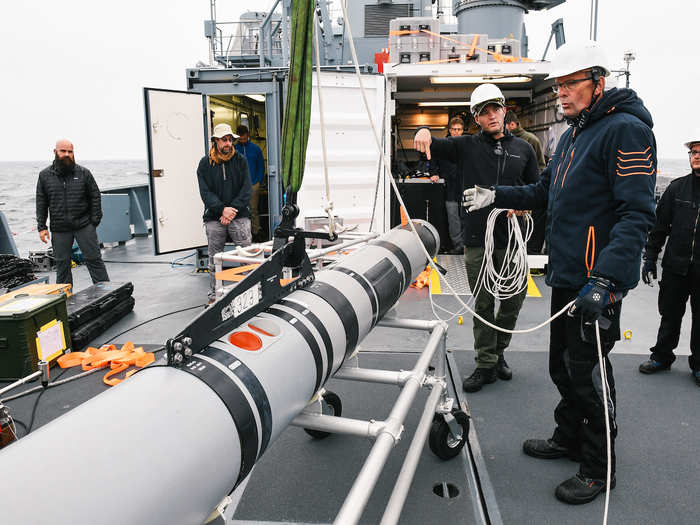


Small Synthetic Aperture Minehunter systems work on a range of wavelengths, providing fine-grain imaging of the seafloor and of small man-made objects as well as peering into the seabed to provide imagery and analysis of buried objects.
The SSAM II module used at BaltOps "provides higher resolution and is intended to hunt bottom mines," said Navy Lt. Matthew Stroup, public affairs officer for the BaltOps 2019 Mine Warfare Task Group.
SSAM II "has two modes; linear [synthetic aperture sonar] mode for rapid search and circular SAS, which provides very high-resolution images to enable" reacquiring and identification, Stroup added.
Autonomous Topographic Large Area Survey forward-looking sonar, known as ATLAS, has a wide search-area width that's meant for volume mine-hunting, Stroup said. It can also be used to gather information, including mapping of clutter and large-object detection on the seafloor and to gauge ocean depth.

Robertson is commander of the Naval Surface and Mine Warfighting Development Center and led the BaltOps 2019 Mine Warfare Task Group.

!["It is great seeing US [mine countermeasures] UUV capabilities performing efforts in my home region," German Bundeswehr Senior Chief Nico Bermann said. "This, tied together with the data gathering and shown interoperability, will benefit future mine countermeasure exercises." "It is great seeing US [mine countermeasures] UUV capabilities performing efforts in my home region," German Bundeswehr Senior Chief Nico Bermann said. "This, tied together with the data gathering and shown interoperability, will benefit future mine countermeasure exercises."](/thumb/msid-60085318,width-700,height-525/60085318.jpg)








 A couple accidentally shipped their cat in an Amazon return package. It arrived safely 6 days later, hundreds of miles away.
A couple accidentally shipped their cat in an Amazon return package. It arrived safely 6 days later, hundreds of miles away. A centenarian who starts her day with gentle exercise and loves walks shares 5 longevity tips, including staying single
A centenarian who starts her day with gentle exercise and loves walks shares 5 longevity tips, including staying single  2 states where home prices are falling because there are too many houses and not enough buyers
2 states where home prices are falling because there are too many houses and not enough buyers "To sit and talk in the box...!" Kohli's message to critics as RCB wrecks GT in IPL Match 45
"To sit and talk in the box...!" Kohli's message to critics as RCB wrecks GT in IPL Match 45
 7 Nutritious and flavourful tiffin ideas to pack for school
7 Nutritious and flavourful tiffin ideas to pack for school
 India's e-commerce market set to skyrocket as the country's digital economy surges to USD 1 Trillion by 2030
India's e-commerce market set to skyrocket as the country's digital economy surges to USD 1 Trillion by 2030

Copyright © 2024. Times Internet Limited. All rights reserved.For reprint rights. Times Syndication Service.